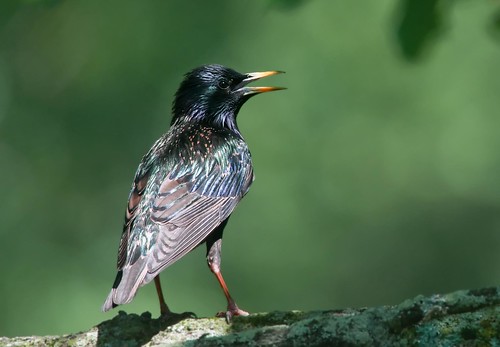Here's all it takes to participate in this weekend's count:
- Look for birds for at least 15 minutes on February 18-21. You can count anywhere; it doesn't actually have to be a backyard.
- Keep track of the species that you see, and for each species, the largest number that you see together simultaneously.
- Enter the information on the GBBC website.
House Sparrow (66% of lists)
Passer domesticus
6.25 inches
If you've got a birdfeeder, you've got house sparrows. These birds were brought over from Europe sometime in the mid-1800s and have proceeded to make quite a home for themselves. Males have a lighter breast with black patch on their throat; females are plain and brown.
Cardinalis cardinalis
8.75 inches
There's something about a bright red bird that makes people happy. But female cardinals are pretty too: a hard-to-define mix of tan, red, and orange, with a bright orange bill. You'll often hear both sexes making short "chip" noises to check on each other.
Zenaida macroura
12 inches
What color is a mourning dove? A brownish-grey, with pink undertones in the breast and maybe some blue if the light hits it right. We almost always see them in pairs or groups, walking around in our yard or perched on the utility lines, where they show off their long tails. Their song is in fact mournful sounding.
Sturnus vulgaris
8.5 inches
This bird is another import that has become widespread. Every once in a while a huge flock lands in our yard to forage, then disappears again. Starlings are smaller than crows, and their beaks are longer and thinner. Juveniles are covered in small white flecks, which make a beautiful pattern.
Turdus migratorius
10 inches
Everyone knows the robin, but you can amuse your friends by learning the Latin name for this bird (my brother in law calls out "turdus!" every time he sees one). Some robins spend the winter in our area, so they're not necessarily a sign of spring -- though they do become more plentiful as it starts to warm up.
Picoides pubescens
6.75 inches
Downies are our smallest woodpecker. I was surprised to see this bird on the list as frequently as robins, but we do see them almost every day on our peanut bird feeder. Males have that red spot on the back of their head; in females it's just white.
Carpodacus mexicanus
6 inches
We used to have a pair of house finches that visited our windowboxes in Dupont Circle and delighted us with their sweet songs and the splash of color on the male's head. These birds are the third import on our list; they're native to the western US, but someone brought them east in the 1950s.
Poecile carolinensis/atricapilla
5 inches
Chickadees are the shortest, roundest birds on our list: fluffy balls of cuteness that fly from tree to tree looking for insects. Washington DC is in the overlap of the range of two hard-to-distinguish species; Carolina chickadees are smaller than their black-capped cousins.
Junco hyemalis
6.25 inches
Juncos are snowbirds -- and Washington is part of their southern winter home. When it warms up a little more, they'll be off for Canada. For now, look carefully for these grey or grey-brown birds on the ground: they can blend in quite sneakily. (See our full post on juncos)
Zonotrichia albicollis
6.75 inches
White-throated sparrows are another winter resident of the DC area. If one thing surprised me more than seeing the tiny yellow patches on this sparrow's head for the first time, it was learning that it's named for the white patch just under its beak, and not that eye-catching yellow. (See our full post on white throated sparrows.)
That should get you started...for more, browse posts about birds here on the Natural Capital, or check out the fantastic online guide at the Cornell Lab of Ornithology.
















